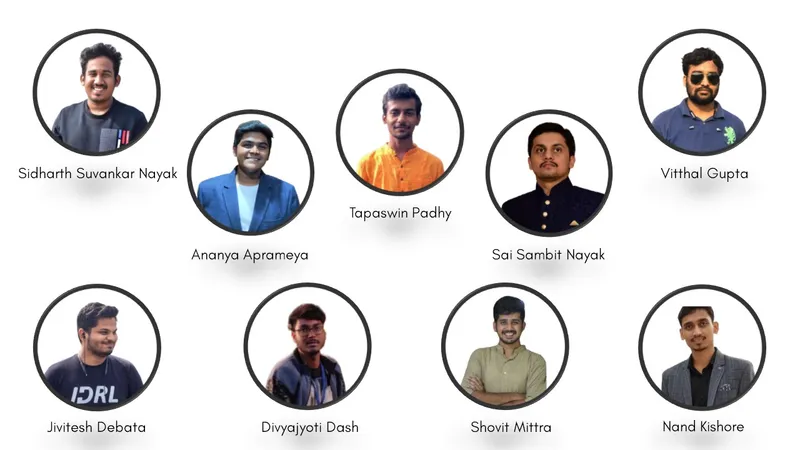Students of IIIT Bhubaneswar create bubble helmet to help COVID-19 patients, frontline workers
Swasner, a helmet ventilator built by the students of IIIT Bhubaneswar, can be used as part of the PPE kits for frontline workers. The patent-pending bubble helmet costs Rs 1,800 per piece.
Earlier, in March, the Indian government lifted the ban on the import of used ventilators, owing to the massive shortage of medical supplies in the country. Six months into the pandemic, according to official data, Make in India ventilators increased in number in August accounting for 96 percent of the 60,000 ventilators procured.
However, the ventilator shortage remains in the country, which has registered over 55 lakh COVID-19 cases and reported close to 88,900 deaths, as on September 22.

Team Swasner
To address this shortage, a group of engineering students from IIIT Bhubaneswar devised a bubble helmet ventilator called ‘Swasner’ for patients suffering from Acute Respiratory Distress Syndrome (ARDS).
Eight engineering students — Tapaswin Padhy, Sai Sambit Nayak, Sidharth Nayak, Ananya Aprameya, Jivitesh Debata, Vitthal Gupta, Nand Kishore Gupta, Divyajyoti Dash, and Shovit Mittra — developed the bubble helmet under the mentorship of Prof Suraj Sharma of IIIT Bhubaneswar, and Sidharth Bhatter, CEO, Karkhana Makerspace.
“When the pandemic was all over the place, we thought, as engineers, we need to do something about the situation. So we finally went with the idea of a bubble helmet ventilator, which is relatively easy to make, inexpensive, and can go a long way in curbing the shortage of ventilators,” Tapaswin Padhy, one of the students involved in the project, tells SocialStory.
The genesis
The idea for bubble helmet Swasner was first presented in the nationwide hackathon organised by Software Technology Parks of India (STPI), where it bagged the sixth position and received prize money of Rs 25,000. Tapaswin says that the team used the money to bootstrap its project.
According to the team, the name Swasner is derived from the Hindi word ‘Swas,’ which means breath.
Swasner claims to be a state-of-the-art modified hyperbaric chamber that can help patients with respiratory ailments to breathe better than a CPAP/BiPAP face mask.
These bubble helmets can be used in place of ventilators by directly plugging it to the available oxygen ports at hospitals, thereby reserving the much-needed ventilators for more critical patients.
Swasner envelopes the patient’s entire head with medical-grade plastic and supplies air through the tubes. At the base, it is sealed with a soft, airtight collar, that wraps around the neck to have a t-shirt-like grip. The tubes fitted to the device have three ports, which supply oxygen, air, and humidified air, that can also be titrated according to the patients need. With the help of the ports, the device can be connected to wall-mounted oxygen cylinders in hospitals.
While the inlet tube supplies oxygen, the outlet tube — which is fitted to an anti-viral filter — lets the exhaled air to escape the chamber.
The team says Swasner has several advantages over the face mask as it is less likely to leak. This enables doctors and nurses to increase air pressure into the helmet, which keeps the airway and lungs open and improves oxygen levels. In fact, it is comfortable to wear since it doesn't touch the face, and patients can see through it well enough to watch television, talk, or read, Tapaswin says.
In fact, in March, a study conducted by the University of Chicago Medicine showed that patients demonstrated a better recovery rate after wearing helmet-shaped ventilator masks than regular ventilator support.
Presently, the student group is making the device to be used as part of the personal protective equipment (PPE) kit for frontline workers. For this, it is testing prototypes by connecting the helmet to an air pump instead of an oxygen supply point.
“This aspect can really help the healthcare workers, police officials, and others, who are most susceptible to the disease. These helmets can be worn for a long time, and can reduce the problems like sweating,” Tapaswin says.
The patent-pending bubble helmet does not need much maintenance and costs Rs 1,800 per piece. The device is easy to use and comes with three bubbles, which can be removed and replaced with a new one, or sterilised by standard disinfection procedures, adds Siddharth Suvankar, another student associated with the project.
Research and trials
The student team at IIIT Bhubaneswar is carrying out further research on the helmet ventilator under the guidance of Dr Bhakti Patel from the University of Chicago Medicine, who has been doing research on this product since 2016. Swasner is also being validated by Respirotech Med Solutions — a Delhi-based medical device manufacturer — to develop the initial prototype to a working product.
“The assembly line is set up at CIPET, Bhubaneshwar. We are also in the final rounds of getting an approval from CIPET to initially deploy the helmets as part of PPE kits,” says Tapaswin.

The students with the prototype model
The team has conducted the prototype trials in two different hospitals in Cuttack (as seen in the video). In fact, they plan to execute clinical tests of the ventilator model on critical patients in the next 1.5 years, since some more research and development is required before human intervention.
“Currently, we are planning to launch it as a PPE kit for frontline workers, and maybe in the next 1.5 years, we can proceed with clinical trials as a ventilator based on the ICMR approvals,” says Siddarth.
While the helmet ventilator idea is being explored and researched in different countries, the students say, they are the only team in India that is working on the product. It was also featured on Helmet Based Ventilation website, which imparts information on non-invasive ventilation (NIV) via a helmet.
The team has also been receiving a lot of requests from different countries, including Mexico, Brazil, Iran, and others, who are interested in setting up an assembly line in their respective countries.
At present, the team is on the lookout for distributors, who can help the product reach consumers.
According to Tapaswin, the product can be used in any containment situation. It can also be used as a viable replacement to PPE kits, in a hope to curb the virus on a small level.
Edited by Suman Singh








